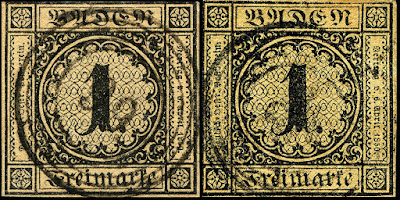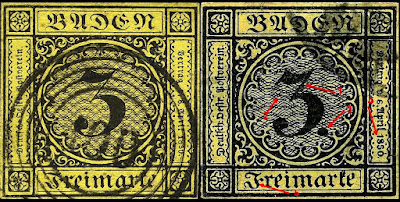On April 6th, 1850, the governments of Austria and Prussia established a Postal Convention for the interchange of correspondence at fixed rates and other German States were invited to join the Union.
Among other things the Articles of this Convention stipulated that, as a rule, correspondence should be prepaid and that such prepayment should be effected by means of postage stamps as soon as practicable.
Baden at once agreed to join the Union.
It was decided to issue four values 1kr, 3kr, 6kr, and 9kr and Mr. C. Naumann, of Frankfort, was commissioned to engrave the dies while the paper was obtained from a local paper maker.
The most economical method would be to print all values in black but use paper of a different color for each value.
The dies for the four values were completed by Naumann on Dec. 20th, 1850, and 100 electrotypes were taken from each of them, except of the 1kr of which only fifty were cast.
It was decided to print the 1kr in sheets of 45, in five rows of nine, and the other values in sheets of 90, in ten rows of nine.
The extra cliches were kept in reserve in case any of the others should become damaged or worn and have to be replaced.
The paper was machine-made, wove, and differed in color for each value.
The stamps were printed by the University printer, Mr. Hasper, of Carlsruhe, using ordinary black printers’ ink.
All the values were reprinted in 1867 and these are very difficult to distinguish from originals.
The left over stock of numeral originals and probably reprints was sold in 1873 to R. Senf, Leipzig.
This blog will only examine the numeral values. The coat of arms and landpost issues will be reviewed in another post.
Genuine Stamps
Fortunately the less expensive used issues are not the main target of forgers as with the unused ones. Except for Mi 1, a few 1862 and postage due stamps, used issues are much more affordable.
For the numeral issues the engravers added secret marks unknown to the public.
The diagram on the right indicates the position of these secret marks.
For the numeral issues the engravers added secret marks unknown to the public.
The diagram on the right indicates the position of these secret marks.
There is some thought that these marks were not intentional but flaws not corrected.
Samples of the most affordable ones.
The "secret marks" are indicated - cancels often blot them.
Michel #'s are used
 |
| 1851 1a, 1851 2a, 1852 2b |
 |
| 1851 3a, 1852 3b, 1851 4b |
 |
| 1853 5, 1853 6, 1854 7 |
 |
| 1858 8 |
Forgeries
Genuine stamps left, forgeries right
Mi 1
1 Slanted N2 Poorly shaped top of 1, top right extends out
3 Large letters especially 1850
4 No secret mark
5 F touches frame
1 Thick corner elements
2 Odd shaped letters
3 Broken background
4 Irregular dot
5 Thick M
6. No secret mark
1 Rough corner design
2 Thick frame line
3 Thick letters
4 Top and serif wrong
5 No secret mark
6 F touches frame
7 Very large letter
1 Thick letters
2 Distorted corner elements
3 No curve in serif
4 Thick broken background
5 No secret mark
2 Odd shaped letters
3 Broken background
4 Irregular dot
5 Thick M
6. No secret mark
2 Thick frame line
3 Thick letters
4 Top and serif wrong
5 No secret mark
6 F touches frame
7 Very large letter
2 Distorted corner elements
3 No curve in serif
4 Thick broken background
5 No secret mark
2 Thick outside frame
3 No curve on top and serif
4 Poorly designed thick background
5 Thick letters
6 No secret mark
7 W instead of an M
Given the crudeness and the spelling "error", this may be the work of Torres
Short right bottom serif of 1
N of BADEN has a spur top right
N of BADEN has a spur top right
Side letters are large
Background behind 1 very heavy
3 Large irregular dot
4 Thick letters
1 Thick frame
2 Wrong background
3 Indistinct letters
4 Thin letters
2 Small Dot
3 Secret mark possible
4 Broken lines
5 Indistinct letters
1 Thick frame
2 B touches frame
3 Very indistinct letters
4 No secret mark
5 Crude background
6 F touches frame
1 Thick letters that touch the frame
2 Coarse crude background
3 Large thick letters
One of the color error forgeries. This one has very thick letters and a coarse background
A much better forgery probably produce in the 1980’s by Peter Winter of Germany.
The side letters do not match and the background is too coarse.
Another Peter Winter forgery from a fake cover
2 Breaks numerous
3 Letters touch the frame
4 Indistinct letters
Part 2 to follow....
NOTE
The real concern with Mi 1 is the adulterated Mi 5.
Mi 1b was printed in one edition of 445,000 stamps, Mi 5 was more than ten times at 5,123,100 issues in five printings.
Although the Mi 5 was printed on a different white paper, fakes of the Mi 1 were produced in large quantities by soaking the Mi 5 in a strong solution of coffee. This arose to the term “Coffee Fake”.
The brownish yellow color generally tends to be inconsistent throughout the stamp but can also be very deceitful.
One major catalog hints that the secret mark is missing in the Mi 5 but this is erroneous.
The other concern is the 1867 reprint which is very hard to distinguish except by color and paper.
 |
| 1B & "Coffee Fake" |
 |
| 1b & 1867 reprint |
Mi 2
1 Thick bar
2 Coarse background3 Large irregular dot
4 Thick letters
5. Tall wider letters
This is probably a cutout from a Menke-Huber postcard (Zurich, around 1902) commemorating the first stamps of Baden
2 Wrong background
3 Indistinct letters
4 Thin letters
1 Thick letters with different shapes
2 Indistinct letters
3 Crude uneven background
4 F touches frame above
 |
| 2a & 1867 reprint |
Mi 3
1 Wrong background2 Small Dot
3 Secret mark possible
4 Broken lines
5 Indistinct letters
1 Large B touches the frame line
2 Coarse irregular background
3 Vestige of a secret mark?
4 Large F touches frame - all the letters are too large
5. Large side letters
Possibly another cutout from a Menke-Huber postcard (Zurich, around 1902) commemorating the first stamps of Baden
2 B touches frame
3 Very indistinct letters
4 No secret mark
5 Crude background
6 F touches frame
This appears to be a photo-litho reproduction with many original traits but a rough blotchy dense appearance
Mi 4
I have seen very few examples of this forgery
Most have concentrated on the very rare green color error
2 Coarse crude background
3 Large thick letters
Possibly another cutout from a Menke-Huber postcard (Zurich, around 1902) commemorating the first stamps of Baden
The side letters do not match and the background is too coarse.
Another Peter Winter forgery from a fake cover
Mi 5
Mi 5 forgeries are uncommon as they served a better purpose as Mi 1 “Coffee Fakes”
1 B touches the frame, other letters are narrow
2 Right top extends out
3 Wide black space
4 Large side letters
5 F touches frame line
This may be a Torres fabrication
Mi 6
1 Crude corner elements2 Breaks numerous
3 Letters touch the frame
4 Indistinct letters
 |
| Mi 6 & 1867 reprint |
Mi 8
 |
| Mi 8 & 1867 Reprint |
Part 2 to follow....
References
Germany States - Muller 1933
Germany States - Hugo Krötzsch 1896
Germany States - Poole 1891
Klaseboer Forgery CD 2019
Germany States Forgeries - Hermann Schloss 1930
Germany States GPS Forgeries
Album Weeds Earee
Timbrex - Schloss 1944
Seranne Forgeries
Early Forged Stamps - Pemberton
Forged Stamps All Countries - Dorn
Fakes & Forgeries of Germany & Colonies - Germany Philatelic Society Inc, 1966
Various Billigs catalogs - 1930's
Forgeries Old and New - A. Johnson
Distinguishing Characteristics of Classic Stamps - SCHLOSS Hermann
Michel Specialized Germany - 2016
Images from personal collection, public auction sites and Germany forum members






















No comments:
Post a Comment
THANK YOU for the feedback. Your comment will be reviewed and appear on this blog within 24 hours
Do you have any pic to share? Use this code [img]your-image-url-here[/img]